With its warm, humid, sometimes subtropical climate, Florida is home to over 550 species of birds. Many birds of Florida arrive here in the winter migrating from the colder northern states. Others simply live here year-round. Whether you are a Florida native looking for a new hobby or are planning to visit the Sunshine State, we offer you a list of the 25 most common Florida birds you will find during the winter. Because the list is so vast and cumbersome, for this article, we narrowed it down to those who live and thrive in Florida year-round.
#1 Anhinga
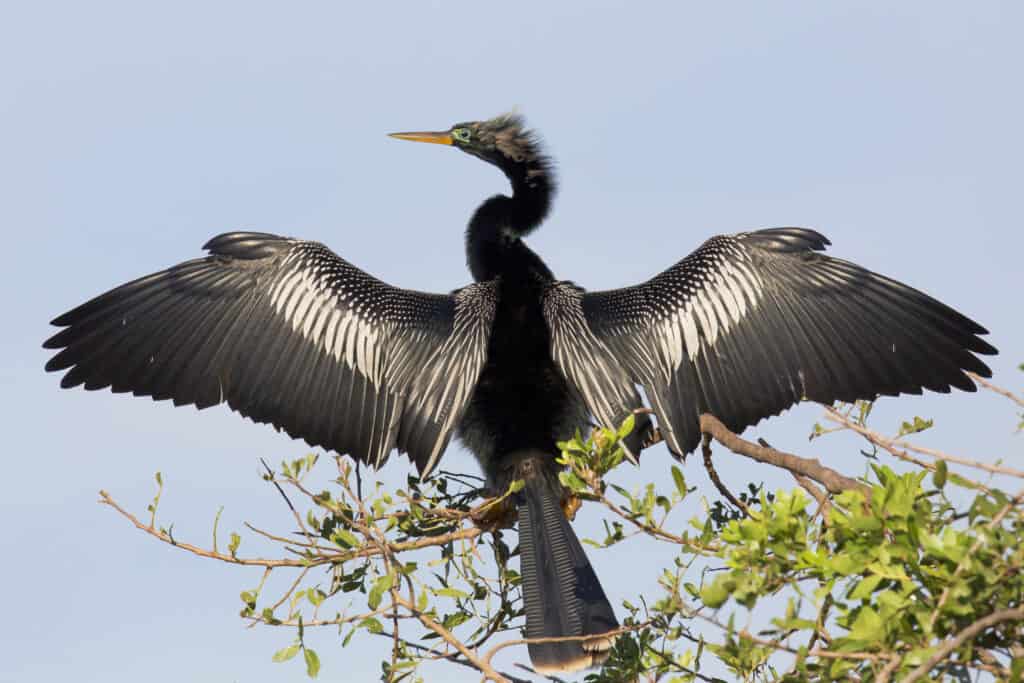
Anhinga birds can dive up to 60 feet below the surface and stay underwater for up to one minute!
©Steven Blandin/Shutterstock.com
Starting with the letter A, we naturally find ourselves thinking about the anhinga bird. Also called snake birds, these large and slender waterbirds have an appearance like that of a cormorant but are slightly smaller. With long daggerlike bills almost the same size as their head, anhingas have long S-shaped necks. They are black with silver and white streaks on their wings. Females and young anhingas have a tan head, neck, and breast, which distinguishes the two sexes from one another.
These diving birds live in shallow freshwater lakes, ponds, and slow-moving streams. They eat prey found while diving headfirst into freshwater sources, including snakes, catfish, mullets, sunfish, crawfish, crabs, shrimp, and tadpoles.
#2 Black-Bellied Whistling Ducks
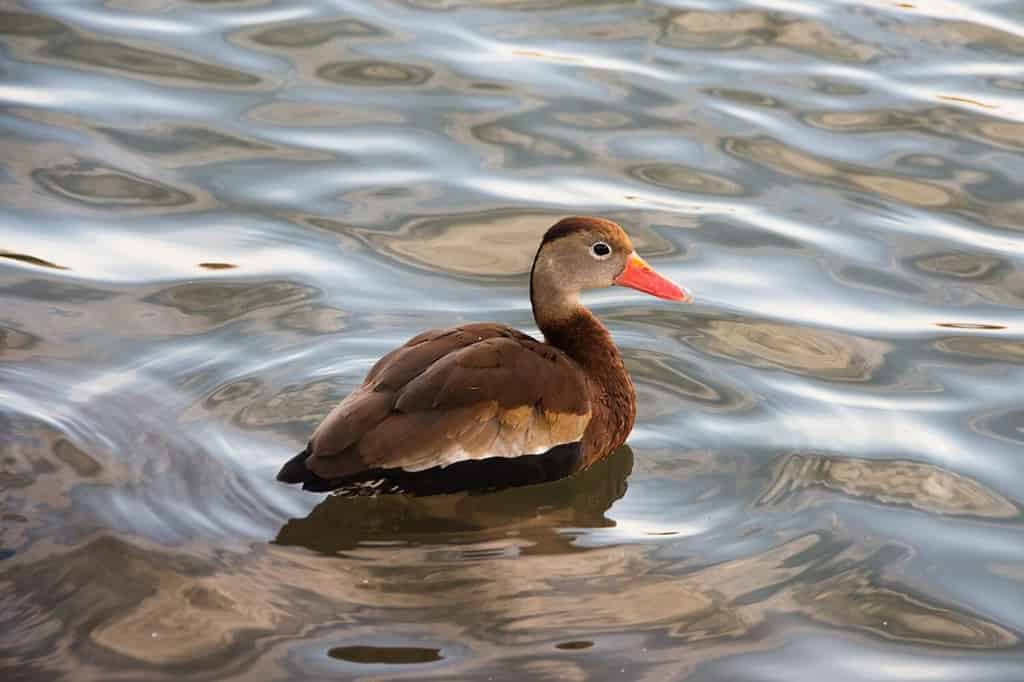
Black-bellied whistling ducks produce a high-pitched sound that mimics that of a whistle.
©Diana Borden/Shutterstock.com
Once only found in central and south Florida during the late summer and early fall, black-bellied whistling ducks have recently become year-round residents throughout the state. They are large birds around the same size as a goose. Each one showcases a black belly, tan breast, grey face, white wings, and a distinguishable pink bill. They dwell in shallow ponds, including schoolyards, parks, golf courses, and ponds formed after a rainstorm. With a variety of different plants available to them, their diet consists of smartweed, amaranth, sedge, swamp timothy, and nightshade. They also feast on wheat, corn, and small insects.
#3 Black-Crowned Night Heron

These birds have digestive acids that allow strong bones to dissolve in their stomachs.
©Nycticorax nycticorax/Shutterstock.com
Black-crowned night herons get their name from their charcoal-colored backs and crowns. They are stocky birds with short legs, thick necks, flat heads, and pointed bills. Most active at dusk, they often perch on tree limbs near water sources. That’s because their diet consists mostly of fish. You can find them dwelling in a variety of fresh and saltwater habitats, including marshes, rivers, ponds, canals, and mangroves. They also eat frogs, squids, clams, mussels, snakes, and rodents.
Over the 20th century, the population of the black-crowned night heron was in steep decline. However, since the ban of DDT in pesticides in recent years, many local populations have increased.
#4 Brown Pelican
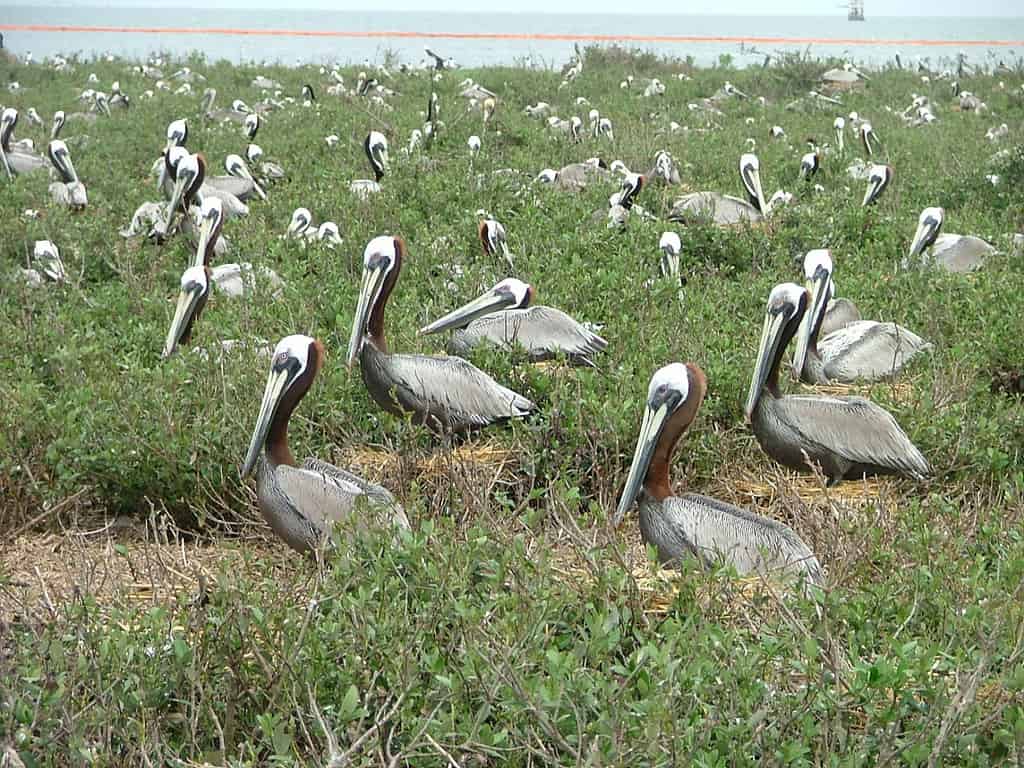
Adult brown pelicans incubate their eggs using their webbed feet.
©External Affairs, CC BY 2.0 – License
Despite being as large as a Canadian goose, brown pelicans are the smallest of the pelican species. Still, their wingspan can reach up to 7.6 feet and measure more than 13 inches. These greyish-brown divers use their throat pouch to scoop up large quantities of water and fish, devouring up to four pounds daily. If you want to catch a glimpse of a brown pelican, you can find these Florida birds along the coast during their nonbreeding season. A severe decline in the 60s and 70s caused these vivacious birds to become protected under Florida’s Endangered and Threatened Species Rule.
#5 Caracara

The crested caracara is the national bird of Mexico.
©FotoRequest/Shutterstock.com
The crested caracara is a member of the falcon family. About the size of an osprey, they are black and white with yellow-orange skin on their legs and face. Looking for this large raptor? You may find this scavenger on the side of roadways feasting on roadkill as their diet consists of small animals, both dead and alive. They also dwell within wet prairies and wooded areas that contain palmetto, cypress, and scrub oaks. The crested caracara is another bird that due to a population decline is listed under the Federal Endangered Species Act and Florida’s Endangered and Threatened Species Rule.
#6 Cattle Egrets
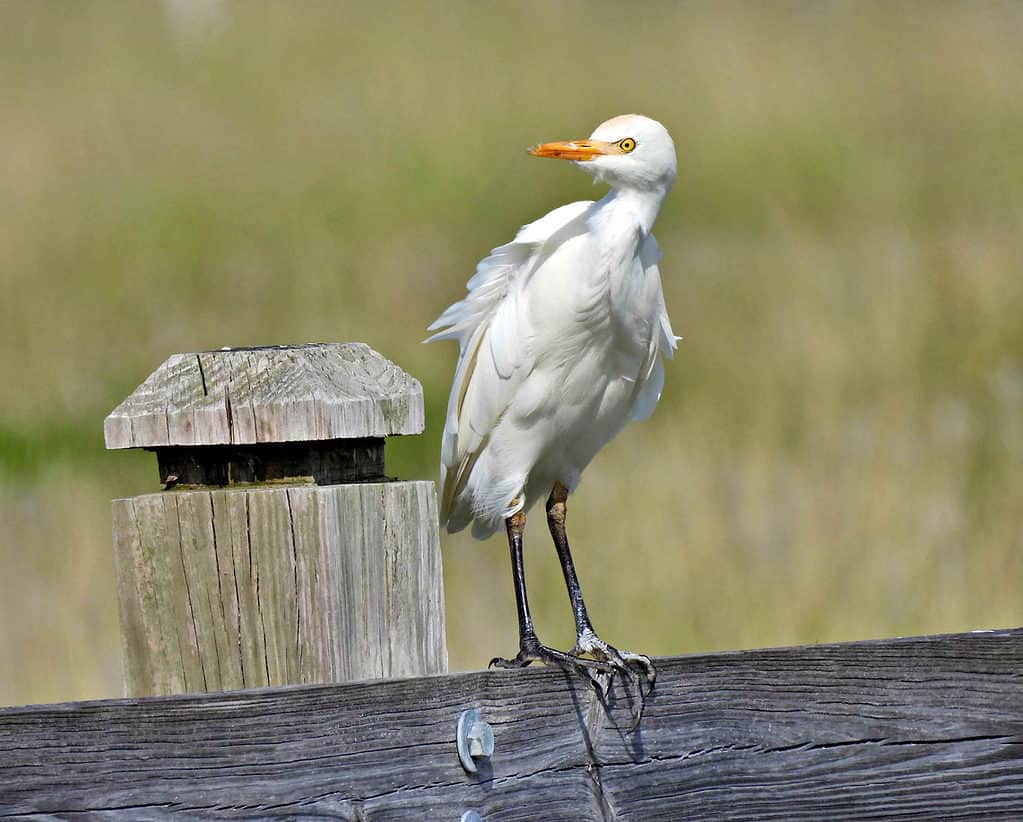
Cattle egrets are actually beneficial to farmers due to the large amount of insects they consume.
©iStock.com/passion4nature
White as the snow, cattle egrets have a bright yellow bill and yellow legs. They are smaller than most herons and have relatively short legs and thick necks. Cattle egrets received their name because they like to graze amongst the fields alongside cattle. You can find these elegant birds of Florida in wide open fields including pastures and inside flooded fields and marshes. They eat a variety of insects such as grasshoppers, flies, crickets, and spiders.
#7 Florida-Scrub Jay
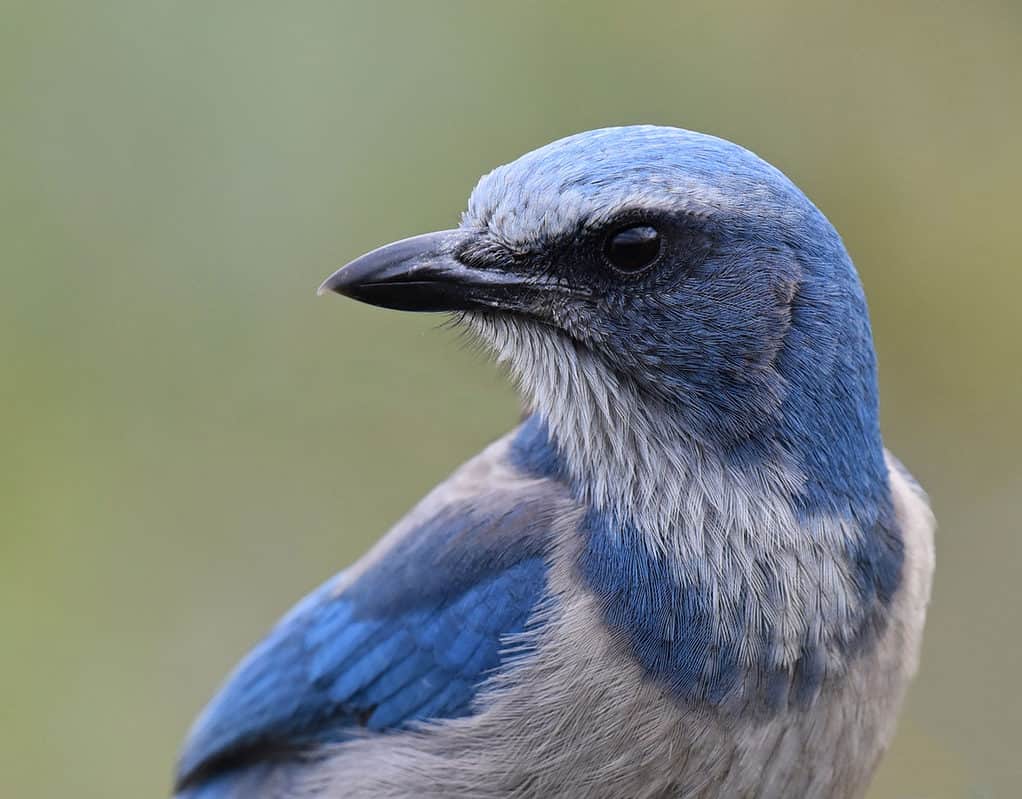
The Florida scrub jay is a cooperative breeder. Offspring stick around and help raise additional young born into the family.
©iStock.com/Rini Kools
The Florida scrub-jay is a large songbird that resides only in the state of Florida. They dwell in sand pine, xeric oak scrub, and scrubby flatwood trees. With eye-catching blue wings, grey backs, and white foreheads and necks, these native birds live on insects, frogs, lizards, toads, mice, bird eggs, and acorns. With current populations listed at only around 4,000 left in the sunshine state, Florida scrub-jays are also on the Federal Endangered Species list and Florida’s Endangered and Threatened Species Rule.
#8 Great Blue Heron
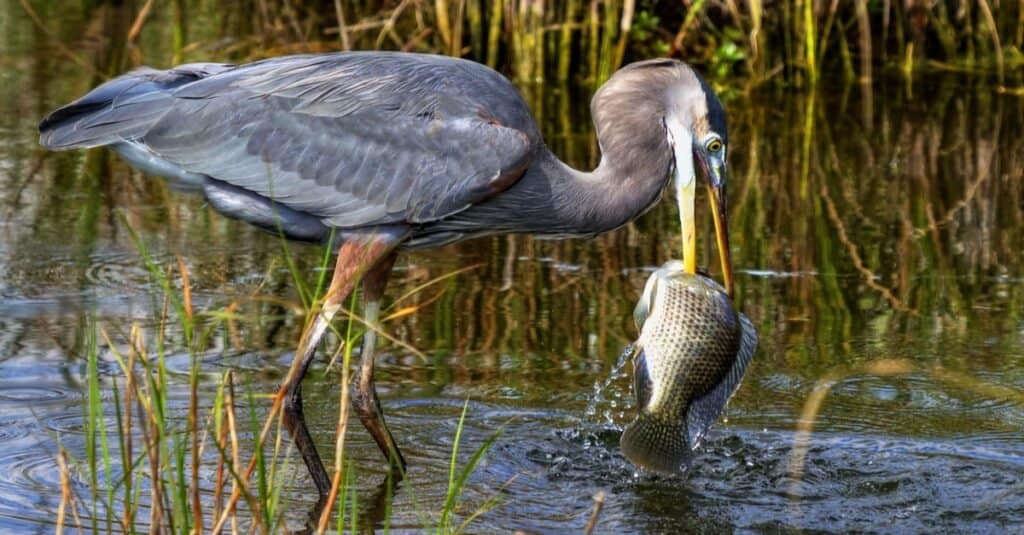
Great blue herons have specialized feathers on their chest that grow continuously and fray into a powder. They use this powder to clean off dirt and grime.
©David Byron Keener/Shutterstock.com
Great blue herons are permanent residents of Florida and are found throughout the state’s vast array of wetlands. They can typically be found standing along shorelines, wading through marshes or rivers in search of food. They are large grey-blue birds with short black plumes on their heads and black chestnut patterns on their shoulders. These majestic-looking creatures eat mostly fish but will consume small animals such as turtles, and even other birds if found while foraging.
#9 Great Egret
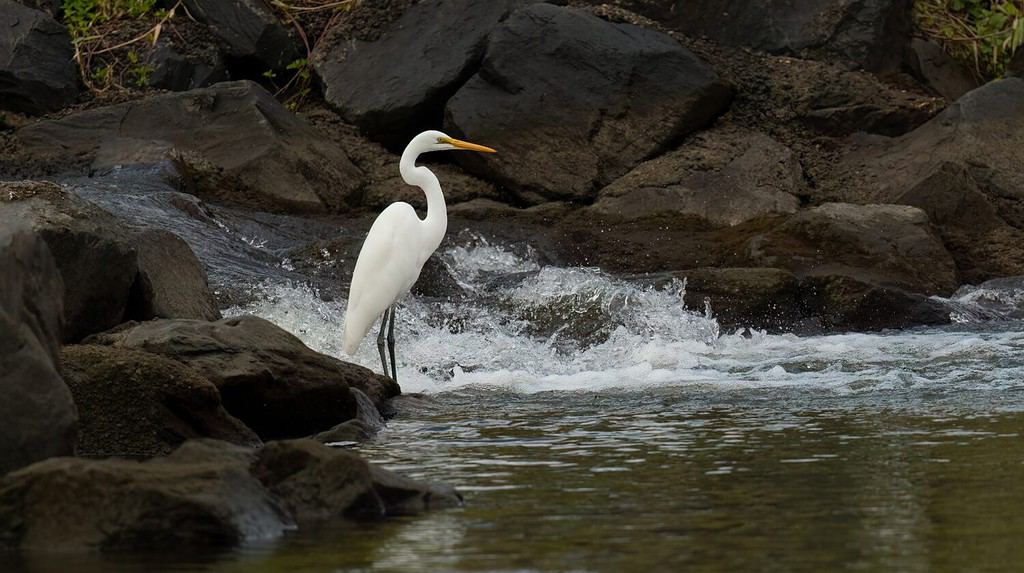
The great egret is the official symbol of the National Audobon Society.
©AlecTrusler2015/Shutterstock.com
With its long, elegant legs and thin curved neck, the great egret sticks close to wetlands, marshes, and swampy areas. This is where it finds its plethora of food choices. Eating a diet of fish, frogs, mice, snakes, crayfish, and insects, they use their long dagger-like bill to jab, kill and devour their meal. Great egrets were almost hunted to extinction in the late nineteenth century, but a ban on hunting and conservation efforts has since increased their numbers.
#10 Green Heron
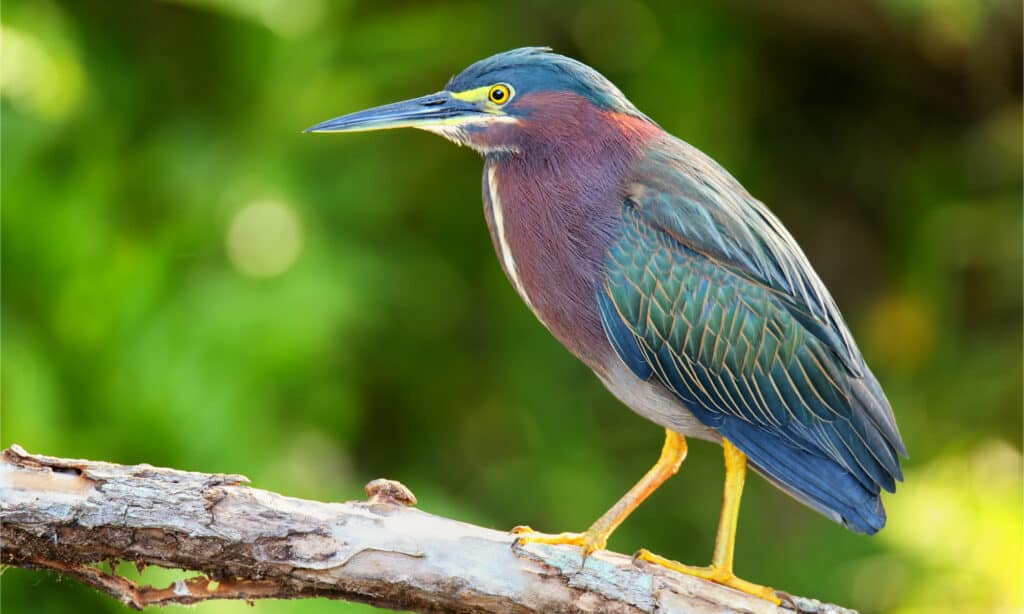
One of the few birds to use tools for hunting, they use bread, leaves, and feathers to try and lure in fish.
©Don Mammoser/Shutterstock.com
A smaller bird at only 17 inches long, the head and body of a green heron are decorated with a prism of colors ranging from black and grey to green and blue. These effervescent birds are quite striking and can be discovered near bodies of water. These nonsocial animals do not like to eat around others and will hang out on the branches of trees waiting for their prey. Their diet consists of small fish and other aquatic life.
#11 Killdeer
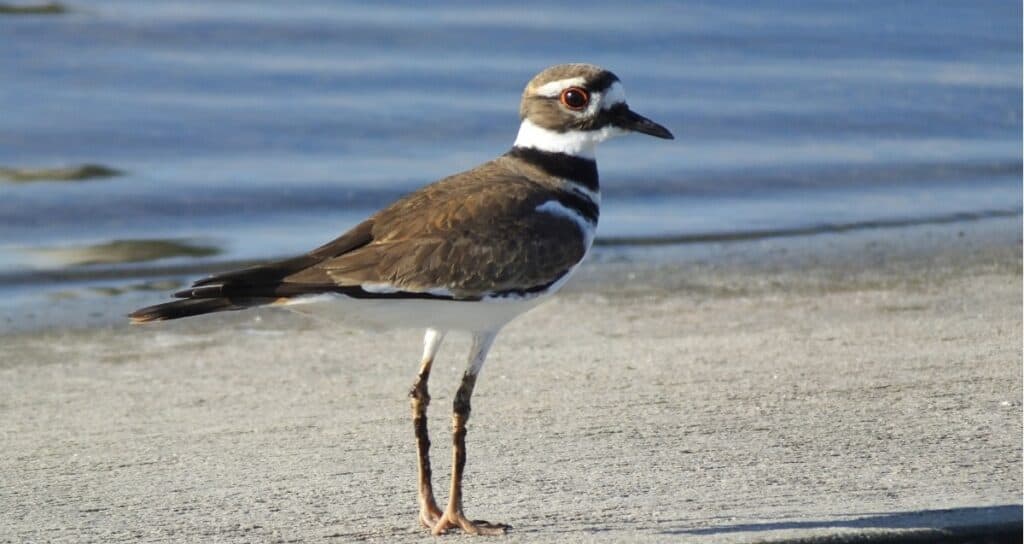
When killdeer are disturbed, they let out long, fast sounds in a rapid sequence that sounds like, “kee-did-di-di.”
©iStock.com/passion4nature
Killdeers are named such for the shrill “killdeer” sound they make. They are slender, with round heads and tan in color with white along their stomach, neck, and forehead. Their distinguishing factor is the black round bands that circle their neck, forehead, and breast. These small birds are born swimmers often living near bodies of water. They can also be found on open ground with sparse vegetation, in fields, on lawns, in parking lots, and even driveways. Killdeer fill their bellies with insects such as grasshoppers, beetles, worms, spiders, snails, and centipedes they hunt for in the ground.
#12 Moorhen
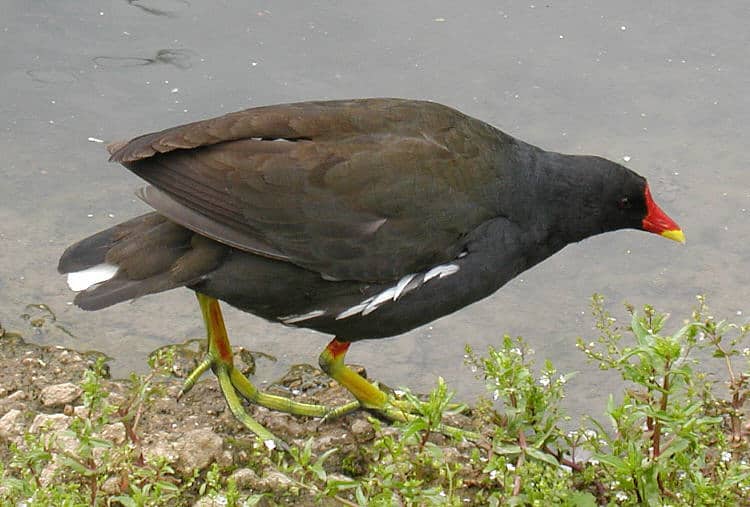
Moorhens are capable of flying but they aren’t very good at it and can only fly short distances at a time.
©Adrian Pingstone / Public domain, from Wikimedia Commons, the free media repository – License
Also called common moorhens or common gallinule, these omnivorous birds are black with sunshine-colored legs and a red beak. Its wings have a strip of white along the edges, and unlike most water birds, they do not have webbed feet. Because they must have water to survive, moorhens inhabit bodies of H20 such as ponds, marshes, and wetlands. They eat anything found in water, including frogs, snails, small fish, lizards, insects, and worms. They will also eat aquatic vegetation or anything that grows near wetlands including fruit, berries, and seeds.
#13 Mottled Duck
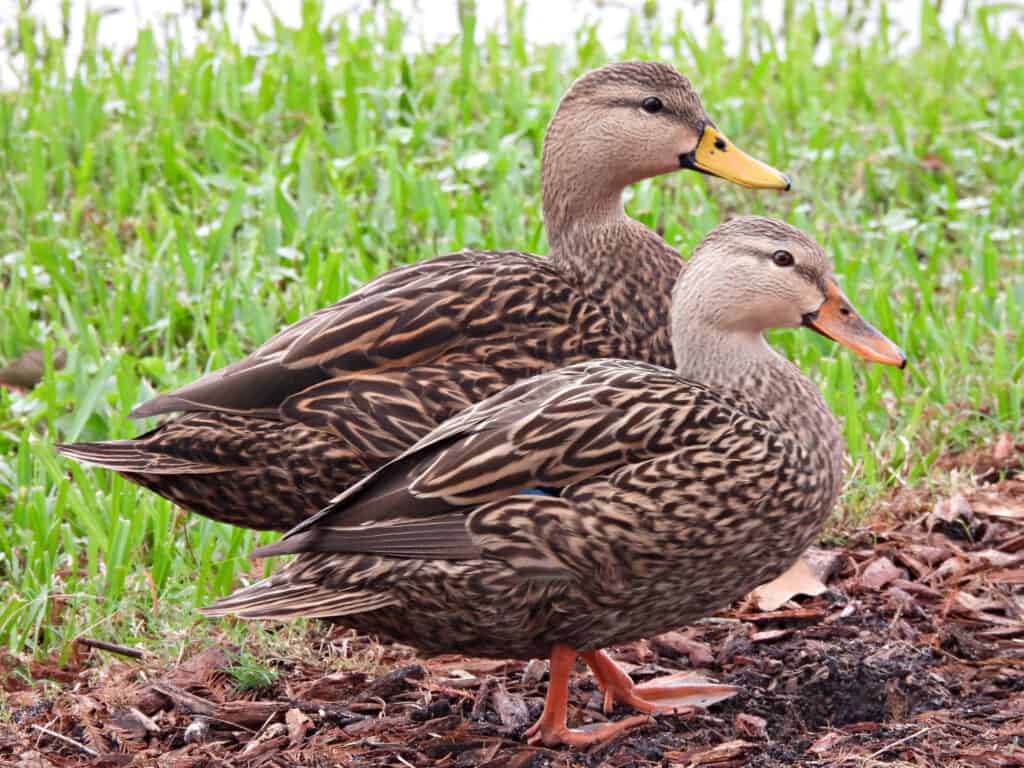
Mottled ducks are nonmigratory and only change locations if absolutely necessary.
©iStock.com/passion4nature
The mottled duck is often referred to as the Florida duck or Florida mallard. It looks so much like a female mallard it is often confused with one. These medium-sized ducks are brown with a buff head and neck and a bright yellow bill. You can take a peek at these dabbling ducks at any of Florida’s freshwater wetlands, flooded fields, mosquito control reserves, and sewage plants. They feed on top of the water’s surface seeking out snails, mollusks, crayfish, insects, and small fish. They also eat grass seeds, stems, roots, and the seeds of marsh plants.
#14 Mourning Dove
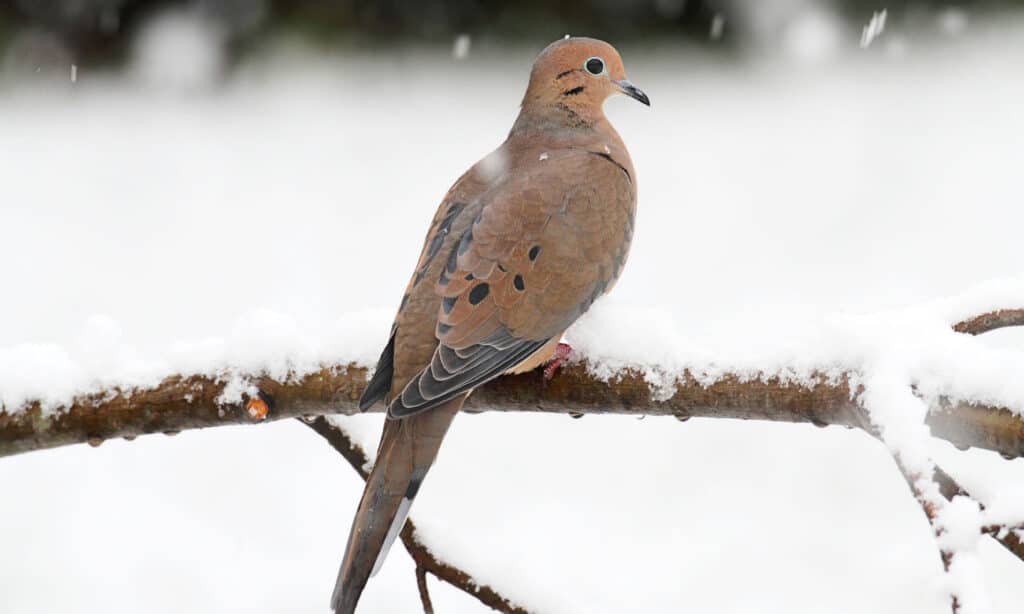
The mourning dove produces one of the most commonly heard sounds in all of North America.
©iStock.com/SteveByland
These common birds can be found throughout the entire United States; however, you can find them year-round throughout the Sunshine State. Mourning doves prefer to dwell in open fields, such as grasslands, plains, and shrublands. These slender, graceful birds are light grey, or brown with a shade of pinkish grey on their underbellies. They have long-tapered tails and black spotting on their wide wings. Mourning doves are ground foragers and munch on a variety of grasses and seeds found at bird feeders.
#15 Northern Cardinal
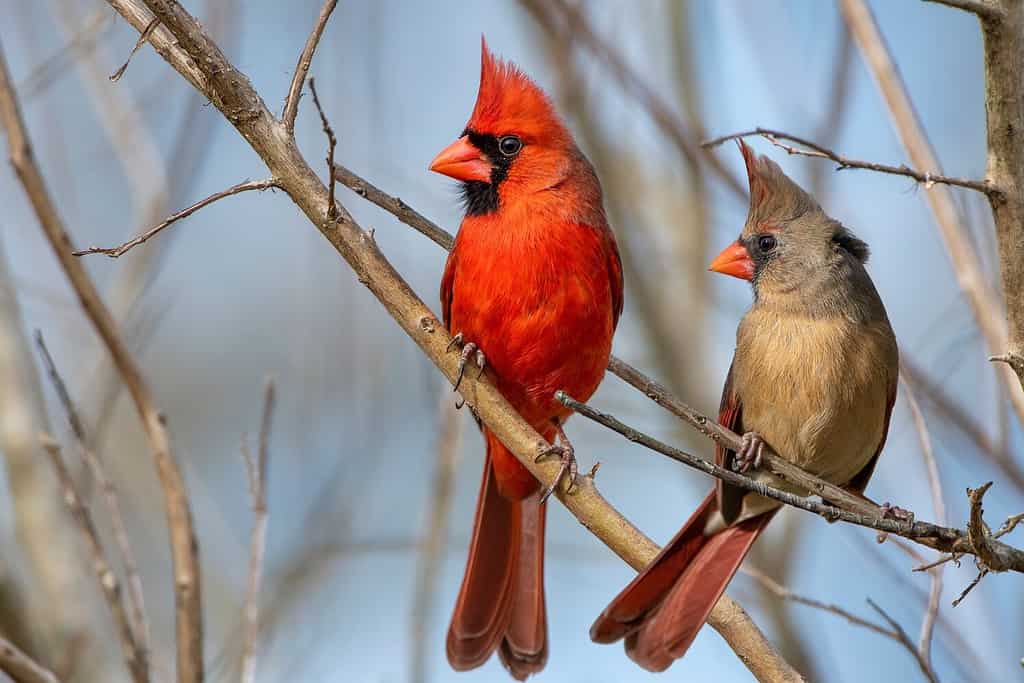
Many people believe that cardinal sightings symbolize good luck or that a loved one who passed is near.
©Bonnie Taylor Barry/Shutterstock.com
This mid-size songbird is highly recognizable by the male’s vibrant red color. Females display a tan color on their back, neck, and breasts. Their wings are dipped in a reddish-orange color, and they portray a black mask around their bright orange bill. These picturesque birds are often seen in trees and shrubs in backyards where their rich color makes them stand out. They also dwell in wetlands, woodlands, and shrublands. The northern cardinal’s diet is comprised of grains, seeds, fruit, spiders, caterpillars, grasshoppers, termites, and beetles.
#16 Northern Mockingbird
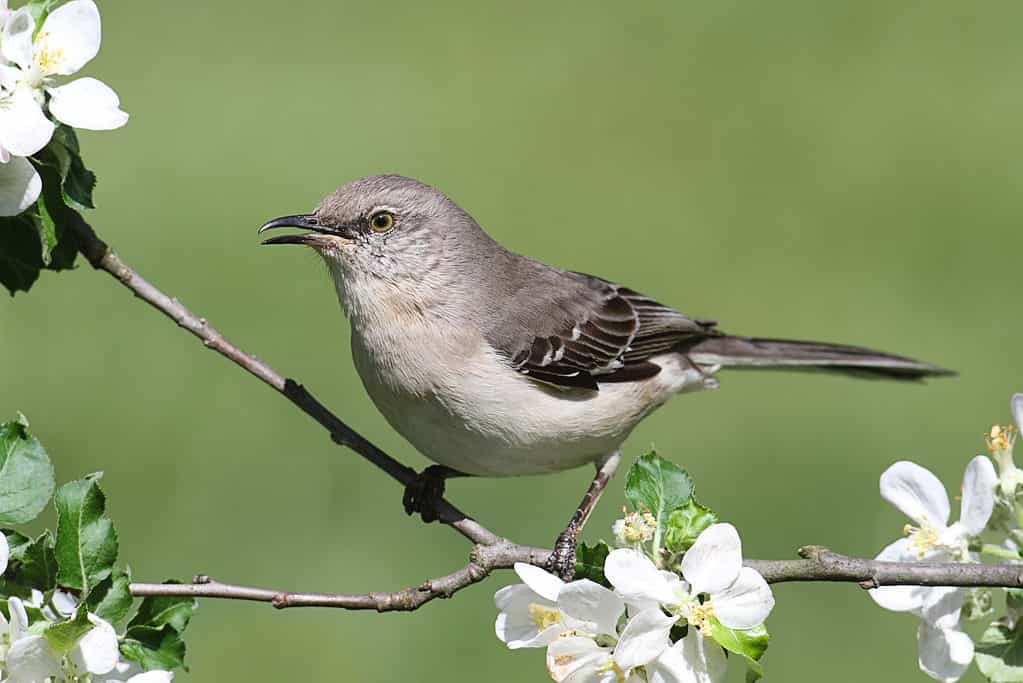
Northern mockingbirds have the ability to mimic and recreate sounds they hear from other birds.
©Steve Byland/Shutterstock.com
We can’t talk about the birds of Florida without mentioning the state’s official bird. Northern mockingbirds can be found throughout the state year-round. These medium-sized birds are predominantly gray with white undersides and white wing patches. Foraging throughout they mostly eat insects, fruits, and seeds. They are attracted to trees and shrubs that provide cover for nesting. Some of their favorites include live oak, red cedar, wax myrtle, yaupon holly, and the southern magnolia tree.
#17 Osprey

Ospreys have the ability to carry fish up to 50% of their own body weight. That’s pretty strong!
©BlueBarronPhoto/Shutterstock.com
Ospreys are large raptors found living and nesting near large bodies of water. This is because they soar above with their giant wing spans ready to pounce below on available fish. With their slender bodies, rounded talons, and reversible toes, they can grab onto slippery fish and devour them in sight. Ospreys are white with brown wings. They have white heads with brown stripes that run through their eyes.
#18 Purple Gallinule
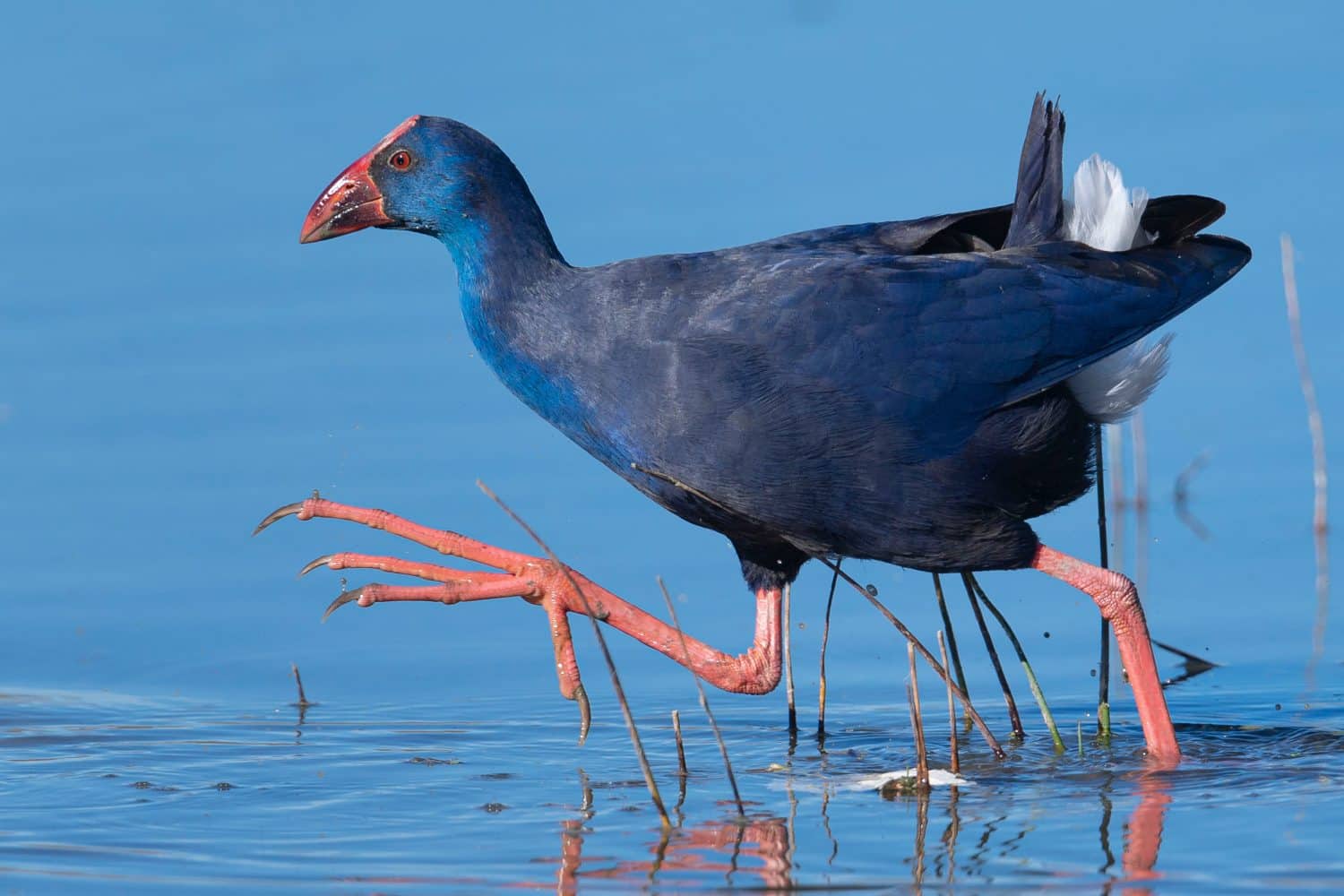
This hard-to-pronounce Florida bird is pronounced ‘pur-pul gal-uh-nool.’
©Jesus Cobaleda/Shutterstock.com
The purple gallinules is a multi-colored Florida bird full of beauty and grace. A medium-sized bird with long yellow legs and a purple head and body, these colorful birds are year-round residents of Florida. You can find them near the edge of wetlands and marshes foraging for plants and insects. This tropical bird feasts on fruit, spiders, beetles, bees, snails, leeches, ants, frogs, small fish, and grasshoppers. While not globally threatened, populations of these Florida birds have been decreasing due to the loss of wetlands and pesticide use.
#19 Roseate Spoonbill
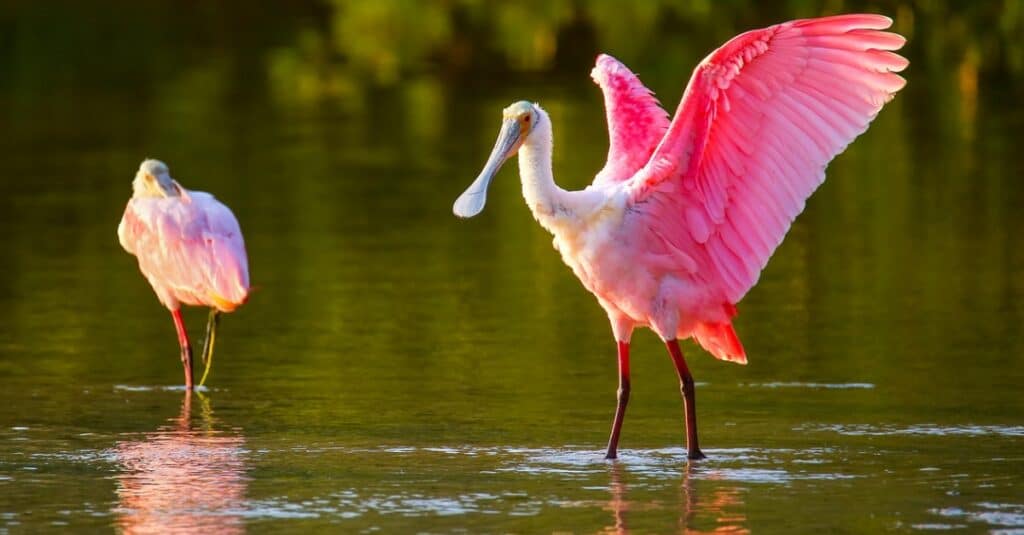
Scientists believe that roseate spoonbills get their pink coloring from the vast amount of shrimp they eat.
©iStock.com/Donyanedomam
These tall Florida birds can grow up to three feet. With small green heads and red eyes, roseate spoonbills have a pale pink coloring to their chest and wings, which may deepen to a dark rose color further in. They have long grey spoon-shaped bills and red legs capable of wading through deep water. These captivating birds live along the Gulf Coast where they are continuously searching for their next fresh meal. Their diet consists of fresh crustaceans such as shrimp and other small invertebrates.
#20 Snail Kite
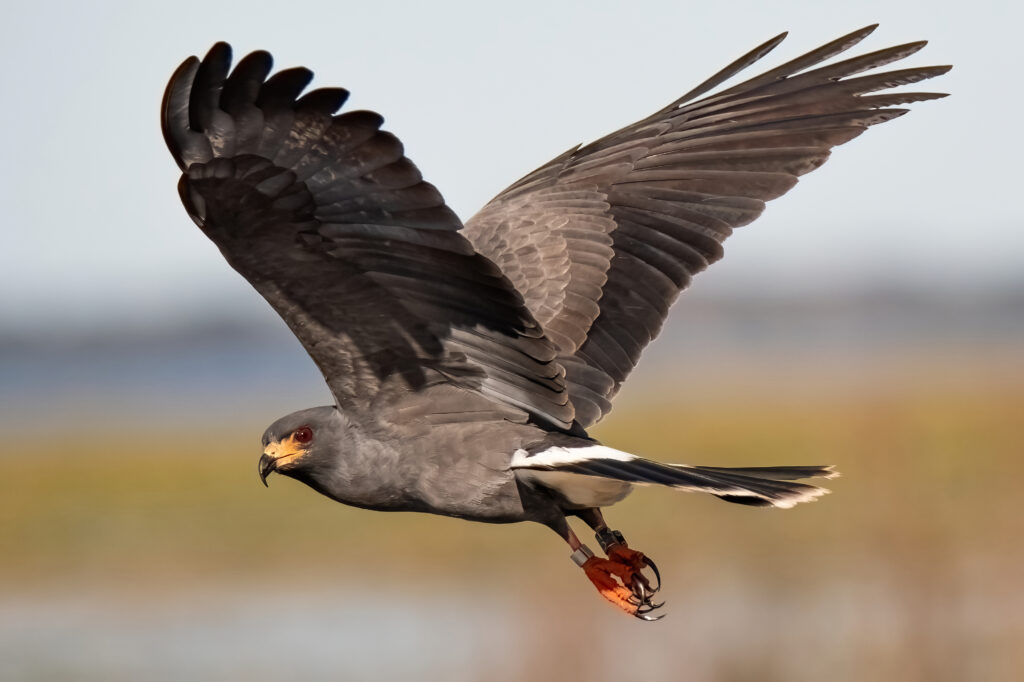
Snail kites have curved bills that fit deep inside snail shells. This allows them to pull out the succulent prey inside.
©John P Ruggeri/Shutterstock.com
The snail kite is a medium-sized raptor with a long tail, long legs, and a thin, hooked bill. The male snail kite is dark gray with a black tail that has white circling the base of it. Females are a dark brown color with white feathering around their faces. Both have paddle-shaped wings. If you want to seek out a snail kite, your best bet is to try Florida’s freshwater lakes and marshes.
Unfortunately, low water levels and the drainage of the Everglades and other Florida wetlands have reduced the snail kite’s only food source, apple snails. Without an adequate amount of apple snails to fill their bellies, this slow-flying bird is dying out. Because of this, the snail kite is currently protected by both the Federal Endangered Species Act as well as Florida’s Endangered and Threatened Species Rule.
#21 Tri-Colored Heron
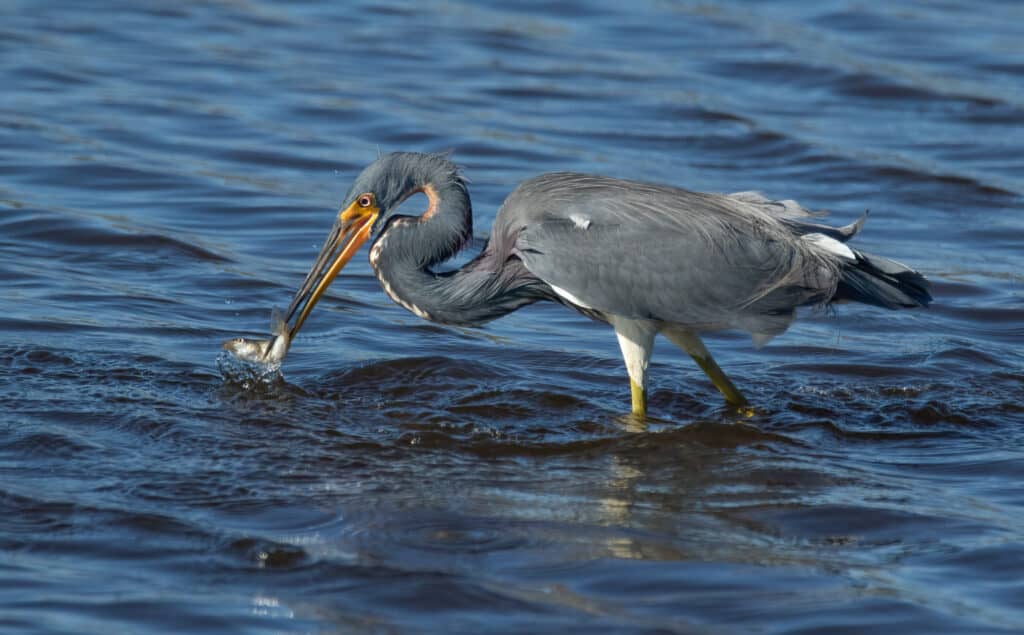
Tri-colored herons are masters at stalking, chasing, and waiting patiently for their prey.
©iStock.com/MattCuda
This medium-sized heron is slim and has a long-curved neck. With its lengthy dagger-shaped bill, it’s easily able to catch its prey. It has a multi-colored body that is a charming mix of blue-gray, lavender, and white. It also has a white belly. You can often find tri-colored herons wading belly deep in marshes, swamps, streams, and shores. These federally and state-protected birds of Florida eat mainly fish, crayfish, tadpoles, frogs, lizards, and insects.
#22 White-Eyed Vireo

White-eyed vireo males sing consistently from spring through late summer in order to protect their nesting territory.
©Paul St. Clair/Shutterstock.com
The white-eyed vireo is a small, exotic-looking bird with a greenish tint. It derives its name from a pair of white eyes surrounded by yellow spectacles. These unique-looking Florida birds contain a bit of yellow with grey heads, white chests and throats, and two white wing bars. It inhabits dense shrubs and bushes in overgrown pastures, fields, forests, and streamside thickets. The diet of the white-eyed vireo consists of caterpillars and berries.
#23 White Ibis
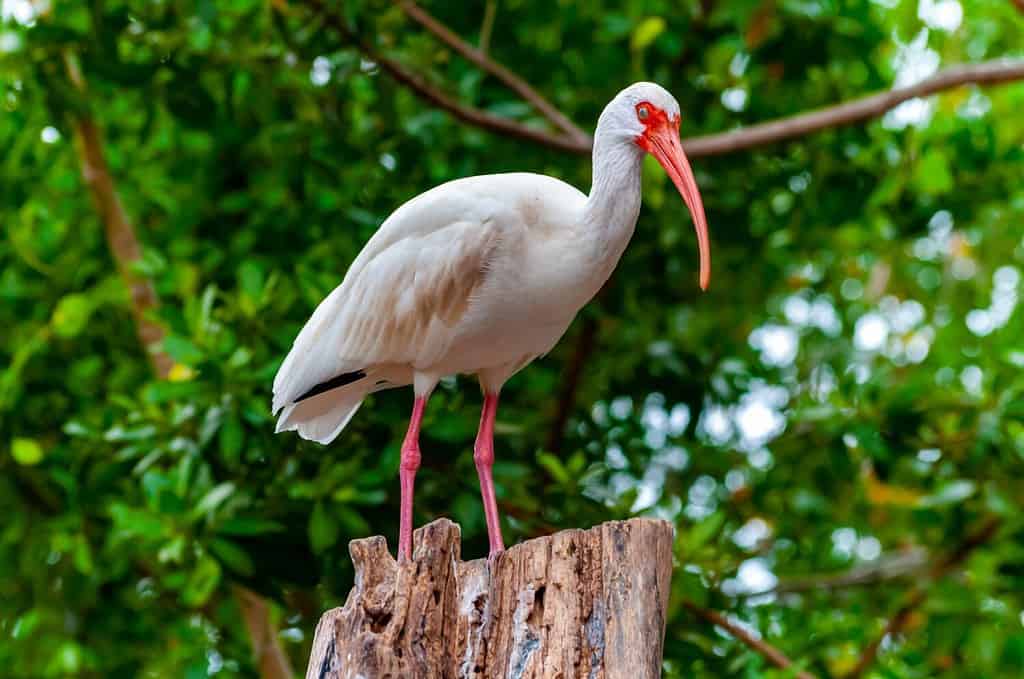
The white ibis spends about 10 hours a day looking for food, 45 minutes flying, and 13 hours resting.
©Oleg Kovtun Hydrobio/Shutterstock.com
The white ibis is a bird full of elegance and beauty. With an almost full white body, it has black-tipped wings, dark red legs, and a dark red bill. A large-sized wading bird, its legs and neck are extremely long and stand straight when in flight. Like many Florida birds, the white ibis spends its days in the wetlands, using freshwater marshes, mangroves, flooded pastures, and swamps. You will also occasionally see them on people’s lawns and parks. They prefer to feast upon crustaceans, including crayfish and crabs, but they will also eat snails, frogs, marine worms, snakes, and insects.
#24 Wood Stork
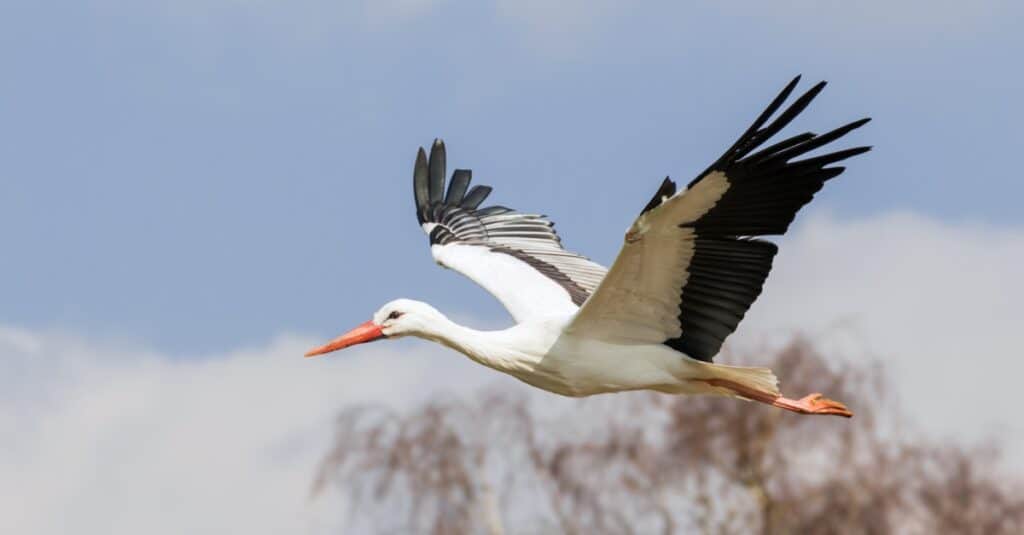
The wood stork uses regurgitated water to keep their chicks cool in the hot sun.
©Ian Duffield/Shutterstock.com
Found only in a few states including, Florida, wood storks are completely white minus their black feathers and tail. Their heads are uncharacteristically unfeathered and quite scaly looking. They are large birds about the size of a goose with a football-shaped body, a long neck, and a long, thick bill. Their bill has a curve at the tip that helps them scoop up their prey when foraging. You can find wood storks with their bills submerged in wetlands, swamps, or ponds looking for fish and other crustaceans.
#25 Limpkin
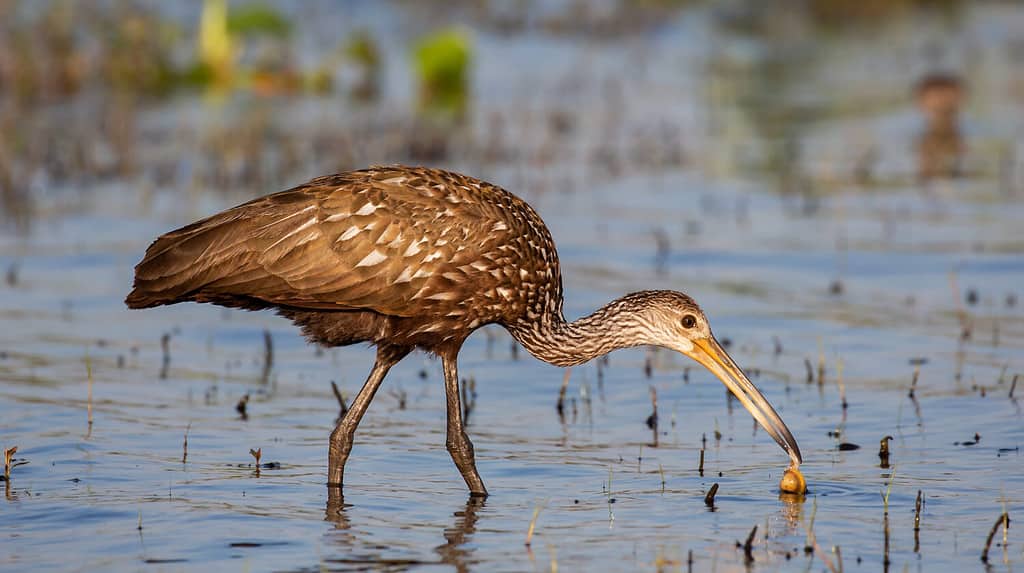
Limpkins create a loud, high-pitched screeching wail.
©Luca Nichetti/Shutterstock.com
Medium-sized waterbirds with dark brown feathers and streaks of white on their heads and necks, limpkins are endemic to Florida. They have long skinny legs and down-curved bills, which they use to feed on their primary source of food, apple snails. Due to overhunting, these leggy birds were once considered endangered. Now, with new laws intact, you can find large populations of them dwelling in shallows along rivers, streams, lakes, and in swamps, marshes, and sloughs. While they prefer apple snails, they also eat frogs, lizards, worms, and insects if food supplies are scarce.
Common Birds of Florida Winters
| Number | Name of Bird |
|---|---|
| 1. | Anhinga |
| 2. | Black-bellied whistling ducks |
| 3. | Black-crowned night heron |
| 4. | Brown pelican |
| 5. | Caracara |
| 6. | Cattle egret |
| 7. | Florida-scrub jay |
| 8. | Blue heron |
| 9. | Great egret |
| 10. | Great heron |
| 11. | Killdeer |
| 12. | Moorhen |
| 13. | Mottled duck |
| 14. | Mourning dove |
| 15. | Northern cardinal |
| 16. | Northern mockingbird |
| 17. | Osprey |
| 18. | Purple gallinule |
| 19. | Roseate spoonbill |
| 20. | Snail kite |
| 21. | Tri-colored heron |
| 22. | White-eyed vireo |
| 23. | White ibis |
| 24. | Wood stork |
| 25. | Limpkin |
The photo featured at the top of this post is © Breck P Kent/Shutterstock.com
Thank you for reading! Have some feedback for us? Contact the AZ Animals editorial team.







